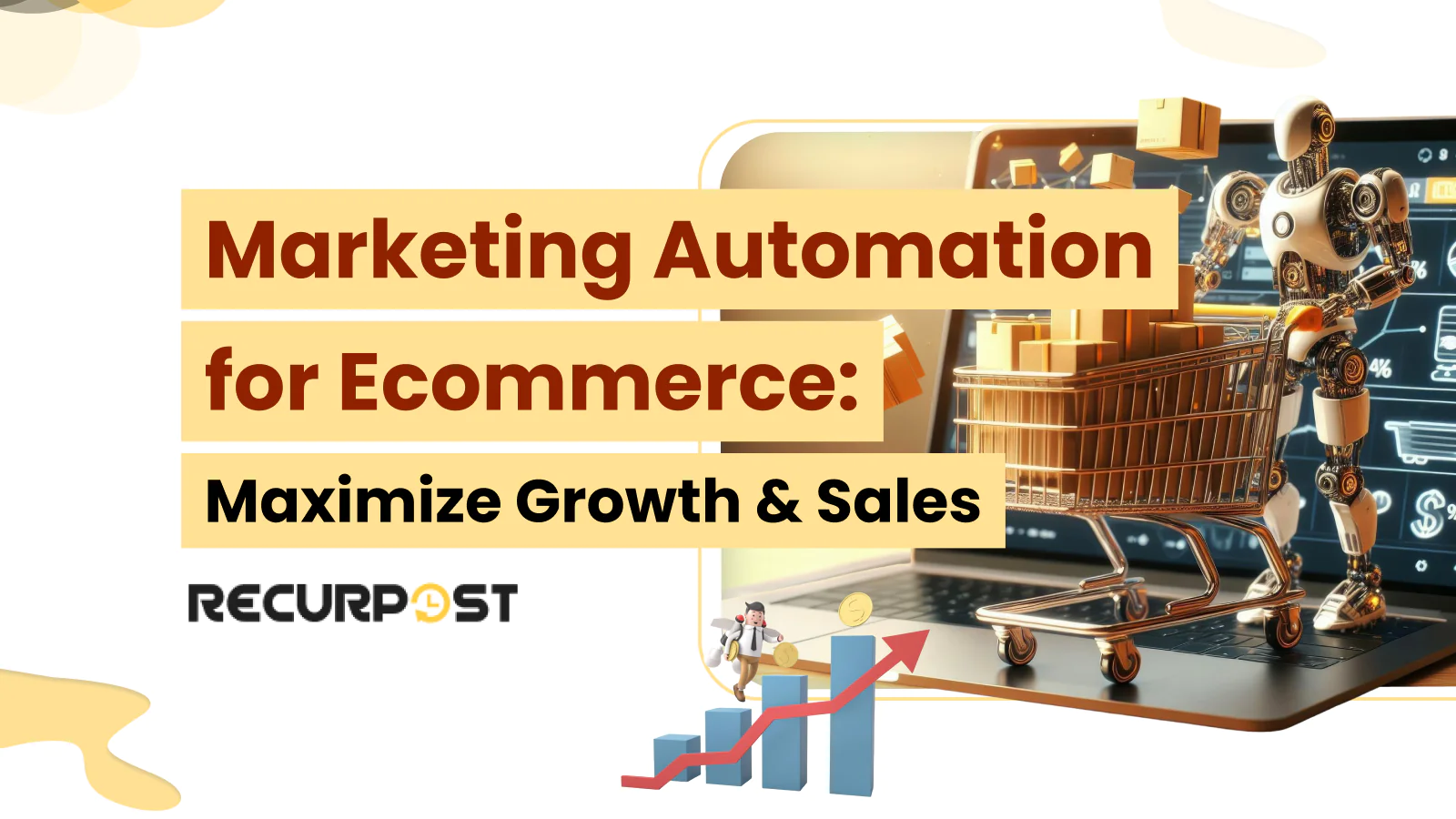Marketing automation for ecommerce reshapes how online stores connect with shoppers. Brands run leaner, faster, and more personalized marketing using eCommerce marketing automation tools instead of juggling manual tasks like email follow-ups and campaign scheduling.
Statista projects the global ecommerce market will grow by 9.29%, reaching $6,478 billion and 3.6 billion users by 2029. That explosive growth comes with rising customer expectations and fierce competition. Marketing teams need smarter ways to scale without burning time or losing accuracy.
Ecommerce automation software steps in as the engine behind smoother marketing efforts. It helps businesses stay consistent across marketing platforms, send personalized messages at the right time, and reduce the risk of human error without increasing workload.
You can automate your marketing processes for an ecommerce store by removing guesswork and replacing repetitive tasks with smart systems, where eCommerce marketing automation gives ecommerce brands the freedom to focus on what really matters: building stronger customer relationships and growing with intention.
This comprehensive guide teaches you how to implement marketing automation for your ecommerce business, where you’ll learn the step-by-step processes that transform manual marketing tasks into automated revenue-generating systems.
What is eCommerce Marketing Automation?
Marketing automation for ecommerce uses software to manage marketing campaigns and customer interactions without manual effort. Ecommerce businesses connect with online shoppers through personalized emails, SMS messages, push notifications, and more—all powered by automated workflows.
Ecommerce brands use eCommerce marketing automation tools to run smart, timed actions based on real shopper behavior rather than manually sending campaigns or handling customer follow-ups. These tools create smoother customer journeys, save marketing teams time, and reduce the risk of human error.
Here’s how ecommerce marketing automation works:
- Automation Tools: These systems run actions like email campaigns, SMS marketing, dynamic advertising, or pop ups based on triggers such as cart abandonment, sign-ups, or product views.
- Marketing Automation Software: Centralizes your marketing tasks like email marketing, digital ads, and push notifications into a single dashboard.
- CRM Integration: Syncs customer data, segments customer profiles, and supports lead management for personalized messaging.
- Automated Workflows: Sends the right message at the right time using behavior-based triggers.
- Ecommerce Platform Connection: Links your ecommerce store to tools that manage customer loyalty, nurture leads, and retarget dormant customers.
This setup allows ecommerce brands from various industries to keep their marketing running without constant manual input, giving business owners and marketing teams room to focus on more important tasks.
Core Components of Ecommerce Marketing Automation
Ecommerce automation relies on automation tools that manage campaigns, trigger personalized emails, and maintain customer relationships without constant input. These components transform marketing tasks into smooth, automated flows that save time and boost consistency.
Email Campaign Automation
Automated email marketing maintains ecommerce store activity across customer touchpoints. Messages from welcome emails to order confirmations and product suggestions trigger based on real-time customer actions.
- Works with any email marketing platform
- Pre-built templates make setup fast
- Helps nurture leads and reduce manual tasks
Example: Allbirds uses automated welcome emails, back-in-stock alerts, and product education flows to stay in touch with new leads and drive product discovery.
Customer Segmentation
Customer segmentation groups online shoppers by actions, interests, or purchase history using customer data. Ecommerce marketing campaigns target specific audiences with personalized messaging through these segments.
- Keeps messaging relevant and timely
- Syncs with CRM and ecommerce automation software
- Improves customer loyalty and retention
Example: Sephora uses loyalty program data and purchase history to tailor product suggestions, email content, and mobile offers by customer profile.
Workflow Automation
Automated workflows streamline tasks across marketing channels with eCommerce marketing automation. Once set, these flows trigger automatically from real-time customer actions.
- Runs across sms marketing, push notifications, email, and programmatic advertising
- Coordinates with CRM, ecommerce store, and ad platforms for automated bid management
- Reduces repetitive tasks like cart recovery, post-purchase follow-ups, and manual ad campaign adjustments
Example: ASOS automates cart abandonment recovery emails, paired with limited-time discounts and delivery reminders to re-engage online shoppers.
Analytics and Reporting

Analytics and reporting track performance across email campaigns, push notifications, landing pages, and digital ads from a single dashboard.
- Built-in analytics dashboards in ecommerce marketing automation software
- Syncs with Google Ads and other analytics tools
- Helps marketing teams monitor engagement and fine-tune their tech stack
Example: Gymshark uses marketing automation platforms to monitor campaign metrics, segment new customers, and adjust marketing efforts based on performance data.
Advertising Workflow Automation

Ecommerce businesses have advertising automation options that include programmatic advertising and automated ad campaigns, which remove manual bid management and campaign scheduling from your marketing workflow while connecting customer behavior data with ad platforms for smarter targeting. Advertising automation connects customer behavior data with ad platforms to run smarter, more targeted campaigns.
- Automates bid adjustments based on conversion performance
- Triggers dynamic product ads when customers abandon carts or browse specific categories
- Syncs customer segments with Facebook Ads, Google Ads, and display networks
- Runs lookalike campaigns using your best customer data
Example: Nike uses advertising automation to serve personalized product ads across social platforms, automatically adjusting creative and targeting based on seasonal trends and customer purchase history.
7 Smart Ways to Use Marketing Automation to Increase Sales
Ecommerce marketing automation uses data, timing, and context to run smarter campaigns. The following strategies transform routine tasks into revenue-generating systems through eCommerce marketing automation software.
1. Recover Abandoned Carts Automatically
Automation tools detect when shoppers exit an ecommerce store without completing a purchase and send reminders within minutes, bringing abandoned cart customers back to complete their purchases.
Ideas:
- Trigger a 3-email sequence: first after 1 hour, second after 24 hours, third with an incentive
- Use SMS for mobile-first users
- Add dynamic product thumbnails and direct checkout buttons
Example: Casper uses personalized messaging with sleep tips and checkout links to re-engage cart abandoners.
2. Cross-Sell with Product Recommendations
Ecommerce marketing automation tools match products to user behavior, increasing order value by recommending complementary items with each purchase.
Ideas:
- Add “You may also like” sections in emails and landing pages
- Show related items during checkout
- Trigger post-purchase emails suggesting accessories or refills
Example: Amazon uses behavior-driven data to fine-tune its recommendation engine and grow average order size.
3. Send Post-Purchase Upsells & Review Requests
Post-purchase automation maintains customer engagement through personalized follow-ups after initial purchases.
Ideas:
- Use email campaigns to promote add-ons or upgraded products
- Trigger review requests 3–7 days after delivery
- Automate tips and tutorials based on what was bought
Example: Glossier sends follow-up emails with how-to content and style recommendations linked to the purchase.
4. Reactivate Dormant Customers
Ecommerce marketing automation software tracks dormant accounts and sparks renewed interest among customers who haven’t engaged recently.
Ideas:
- Run win-back campaigns with limited-time offers
- Target segments that haven’t opened emails in 30+ days
- Use push notifications with reward points or sneak peeks
Example: ASICS reconnects lapsed customers with SMS alerts offering exclusive product drops.
5. Personalize Offers Using Behavior & Segments
Customer profiles reveal shopper preferences, purchase timing, and browsing patterns. This data guides personalized marketing campaigns through automation.
Ideas:
- Create personalized emails using previous product views
- Send birthday offers or location-based messages
- Use AI tools to predict timing for next purchase
Example: Stitch Fix combines quizzes, purchase history, and browsing data to build customized shopping experiences.
6. Automate Loyalty Program Communications
Ecommerce marketing automation tools keep loyalty program members engaged through timely and relevant updates. Antavo reports more than 50% of business owners express satisfaction with their loyalty programs.
Ideas:
- Send monthly loyalty point summaries
- Trigger emails for rewards unlocks or early access invites
- Use mobile apps and push notifications to create real-time excitement
Example: Starbucks automates rewards milestones with visuals, personalized perks, and push reminders.
7. Automate Advertising Campaigns with Smart Targeting
Advertising automation goes beyond manual ad management by connecting customer data with programmatic ad buying. When your email marketing platform and ad platforms work together, ecommerce brands can run dynamic product ads, automated bid management, and behavior-triggered campaigns without constant oversight.
Ideas:
- Set up dynamic product ads that automatically show items from abandoned carts
- Use automated bid management to adjust spending based on conversion data
- Create programmatic advertising workflows that retarget customers across Facebook, Google, and display networks
- Run automated lookalike campaigns based on your best customer segments
- Schedule seasonal ad campaigns that activate based on inventory levels
Example: Wayfair syncs CRM lists with Google Ads to serve dynamic ads tied to on-site activity and abandoned sessions, while using automated bidding to optimize ad spend across thousands of products.
Top Marketing Automation for eCommerce
The right eCommerce marketing automation software aligns with your business operations, product offerings, engagement methods, and existing tech stack. Effective platforms remove manual tasks, connect customer data, and streamline operations across marketing channels.
Here are the best marketing automation tools and software available for ecommerce businesses, where each platform offers specialized features that cater to different business requirements:
Klaviyo
Klaviyo ranks among the top-rated marketing automation solutions specifically designed for ecommerce brands, where this platform syncs with most ecommerce platforms and sends personalized emails based on shopper behavior.
Ideal for: Growing ecommerce stores
Works with: Shopify, BigCommerce, WooCommerce
Strength: Email campaigns, automated workflows, and sms marketing
Omnisend
This platform supports email, sms, push notifications, and integrates with your ecommerce store. Pre-built templates of Omnisend speed up campaign launches without heavy setup.
Ideal for: Fast-moving teams
Works with: Magento, Shopify, Wix
Strength: Omnichannel campaigns with strong customer segmentation
ActiveCampaign
ActiveCampaign is all-in-one solution that blends email marketing, customer relationship management, and ecommerce automation under one dashboard.
Ideal for: Ecommerce stores looking for marketing and lead management in one place
Works with: WooCommerce, BigCommerce, custom stores
Strength: Email sequences, contact scoring, and personalized messaging
Drip
Drip is purpose-built for ecommerce marketing and gives marketing teams access to data-driven campaign triggers across mobile apps, landing pages, and email marketing platforms.
Ideal for: Direct-to-consumer ecommerce brands
Works with: Shopify, WooCommerce
Strength: Visual workflows, ecommerce automation software integrations, and powerful tools for customer retention
Common Mistakes and How to Avoid Them
Missteps in setup, data handling, or campaign logic can disrupt customer journeys and waste marketing teams’ time despite using quality automation platforms. The following section identifies common mistakes ecommerce businesses make and provides solutions.
- Over-Automating Without Testing: Launching too many workflows at once can overwhelm new customers or cause message overlaps. Always test flows on a small segment before rolling them out storewide.
Tip: Start with one or two high-impact flows—like welcome emails or cart reminders—then expand.
- Ignoring Segmentation: Sending the same email campaigns or digital ads to every shopper can feel robotic. Using ecommerce automation software without segmentation misses the chance for personalized messaging.
Tip: Segment by product views, order value, or browsing habits using your marketing automation tool’s filters.
- Outdated or Messy Customer Data: Automation tools rely on clean data. Mistakes like misspelled names, duplicate profiles, or outdated contact details can cause broken campaigns and poor targeting
Tip: Schedule monthly cleanups inside your CRM or email marketing platform to remove inactive records or sync gaps.
- No Connection Between Tools: Marketing tools that don’t talk to each other can cause delays and human error. An ecommerce store, CRM, and marketing automation software should always be synced.
Tip: Use integrations or native connectors across your tech stack—this keeps customer touchpoints unified and consistent.
- Missing Human Checkpoints: Even with powerful tools and ai-powered automation software, some tasks still need a review. Skipping manual checks on campaigns, links, or content can lead to brand damage.
Tip: Set review steps into your workflow before pushing live—especially during new product launches or seasonal promotions.
How to Measure Success of Marketing Automation
Marketing teams must track metrics that reflect real customer behavior rather than surface-level statistics. Ecommerce businesses using automation software should measure these key performance indicators:
1. Email Open Rate & Click Rate
These show how well your email marketing grabs attention and drives engagement. If numbers drop, your subject lines, send times, or content layout might need adjustments.
- Monitor through: email marketing platform dashboards
- Best for: measuring initial interest across customer touchpoints
2. Cart Recovery Rate
This tells you how many abandoned carts turn into actual purchases after automation kicks in. A steady lift here means your automated workflows are connecting at the right time.
- Best tracked in: ecommerce automation software or CRM
- Boosts: conversions from online store traffic
3. Repeat Purchase Rate
This number shows how many customers return to buy again—crucial for ecommerce stores that depend on loyalty.
- Tied to: personalized emails, sms marketing, and loyalty messaging
- Signals: customer experience quality and automation timing
4. Customer Lifetime Value (CLV)
CLV tracks how much a customer is worth across their relationship with your ecommerce brand. It helps shape your marketing efforts and customer support investment.
- Measured through: CRM + marketing automation tool
- Supports: long-term ecommerce marketing planning
5. ROI by Campaign
Every marketing campaign should connect with a measurable business outcome. Whether through google ads, push notifications, or email campaigns—track ROI to tie automation to real sales.
- Review in: marketing automation platform + connected dashboards
- Useful for: budget planning and tech stack decisions
To Sum Up
Marketing automation for ecommerce delivers clear results beyond convenience. Automation tools track campaign performance in real time, helping ecommerce businesses make data-based decisions. The numbers from top-performing email subject lines to repeat purchase behavior guide strategic moves rather than guesswork.
Marketing automation reduces human error, connects businesses with targeted audiences, and refines messages matching the customer journey. A boutique skincare brand increased customer retention after implementing email workflows based on shopper activity.
Successful ecommerce brands combine smart automation with thoughtful content and customer insight. Regular campaign reviews maintain relevance even with powerful automation tools.
Ready to skip repetitive tasks and build campaigns that work while you sleep?
FAQs
1. Can marketing automation work for ecommerce businesses with only a few products?
Yes. Even a small catalog can benefit from automation—such as welcome emails, restock alerts, or abandoned cart reminders. The size of your product range doesn’t limit the value of personalized communication.
2. How do I know if my ecommerce business is ready for marketing automation?
If you’re repeating the same manual tasks (like sending similar emails or tracking customer actions in spreadsheets), it’s time. A growing customer base or rising order volume are also clear signs.
3. Does marketing automation require a developer or IT team to set up?
Not always. Most marketing automation platforms offer drag-and-drop workflows, pre-built templates, and no-code integrations with ecommerce platforms like Shopify or WooCommerce.
4. What’s the difference between CRM and marketing automation software?
CRM stores and organizes customer data, while marketing automation uses that data to trigger timely messages and campaigns across channels like email, SMS, or ads.
5. Can automation tools track customer behavior across mobile apps and websites?
Yes. Many tools monitor actions like app logins, product views, clicks, and cart activity to fuel behavior-based workflows and retargeting campaigns.

Ruchi Dhimar is a skilled content writer with 4 years of experience. She is passionate about crafting compelling narratives, specializing in writing content for different industries.
